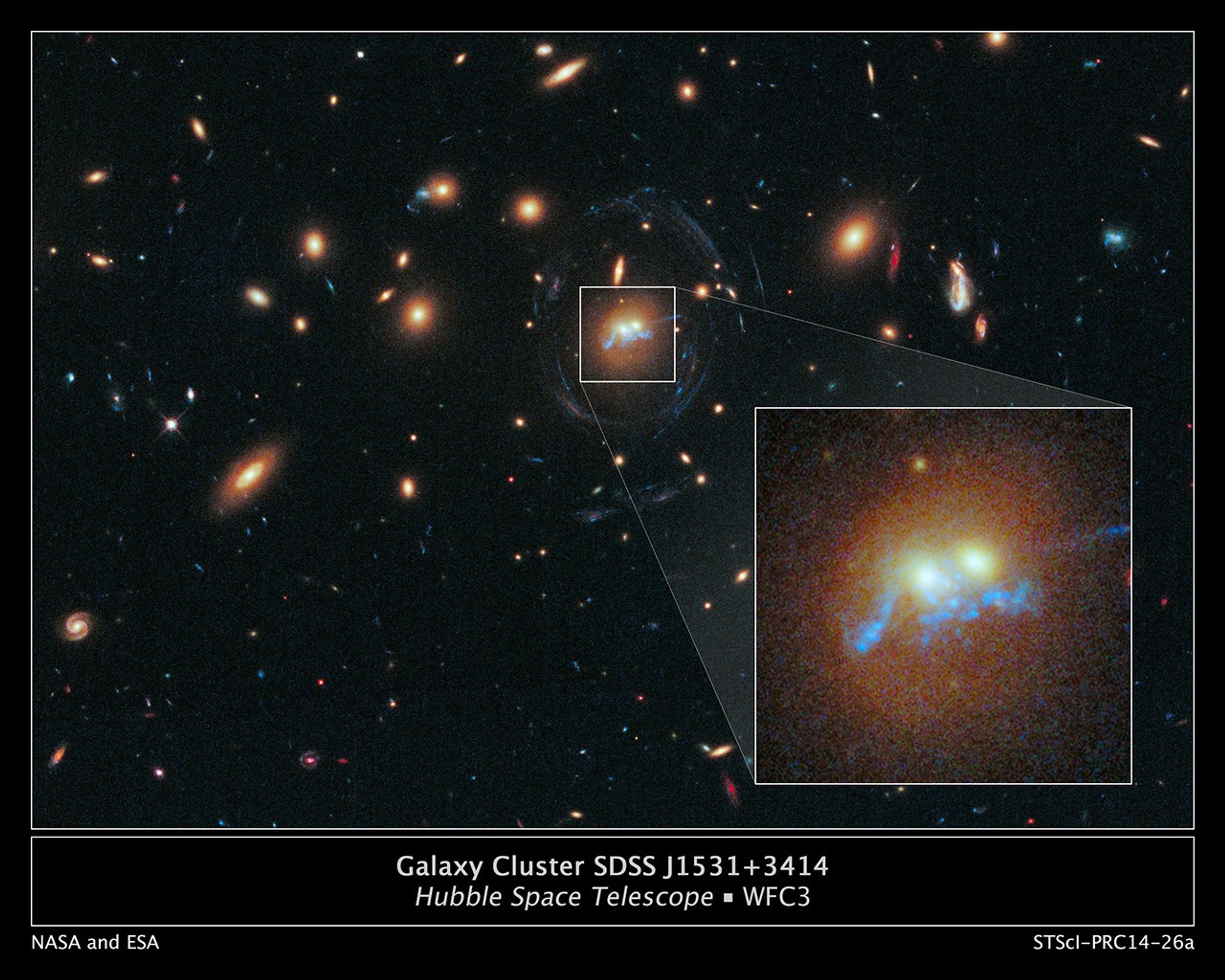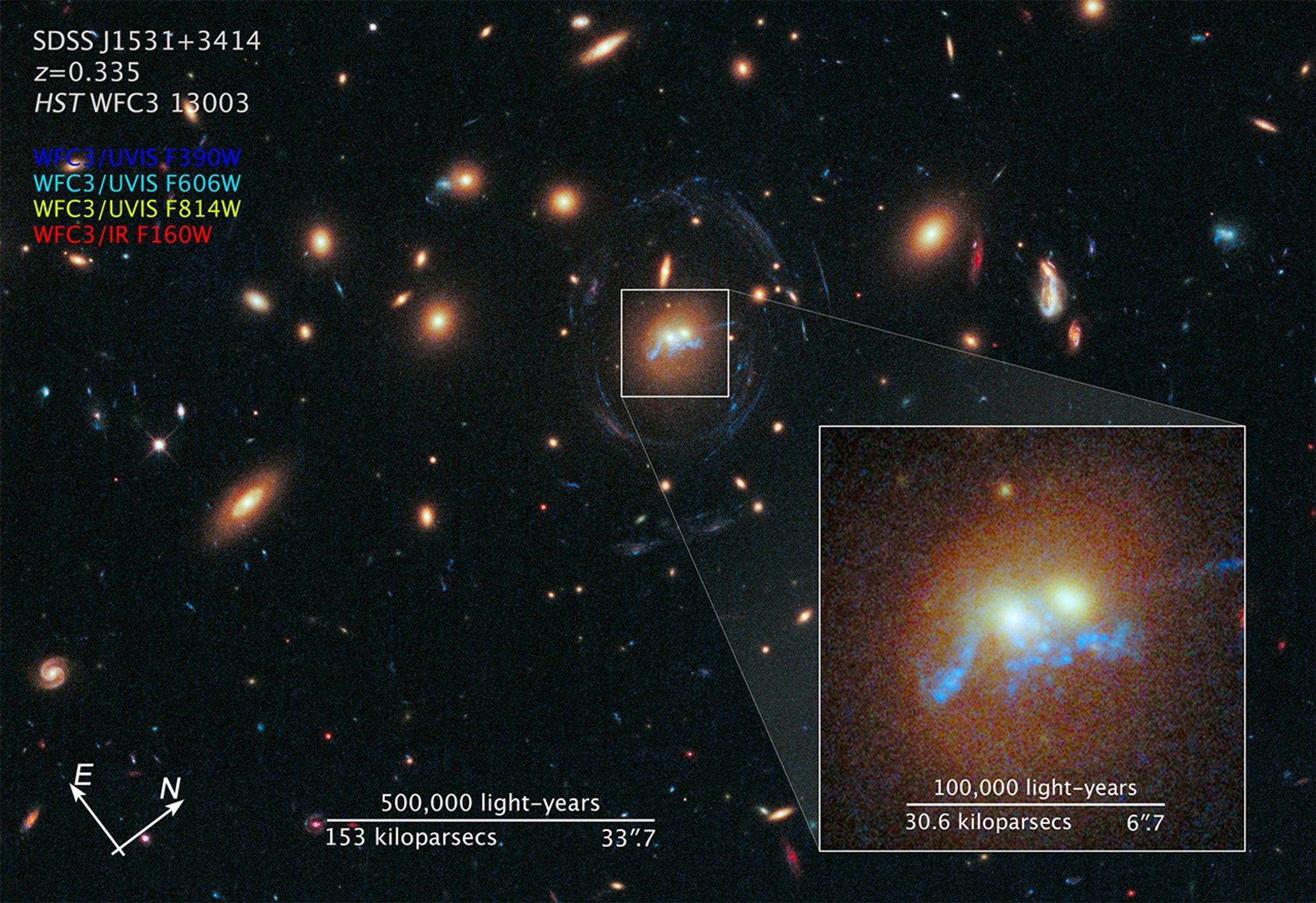1 min read
Galaxy Cluster SDSS J1531+3414 (Clean)

NASA's Hubble Space Telescope has photographed the dense galaxy cluster SDSS J1531+3414 in the northern constellation Corona Borealis. Made up primarily of giant elliptical galaxies with a few spirals and irregular galaxies thrown in for good measure, the cluster's powerful gravity warps the image of background galaxies into blue streaks and arcs.
At the center of the bull's-eye of blue, gravitationally lensed filaments lies a pair of elliptical galaxies that are also exhibiting some interesting features. A 100,000-light-year-long structure that looks like a string of pearls twisted into a corkscrew shape winds around the cores of the two massive galaxies. The "pearls" are superclusters of blazing, blue-white, newly born stars. These super star clusters are evenly spaced along the chain at separations of 3,000 light-years from one another.
Astronomers first hypothesized that the string of pearls was actually a lensed image of one of the background galaxies. Upon closer inspection, it was revealed that the two elliptical galaxies are in the process of interacting and are beginning to share material between themselves.
The underlying physics behind the "beads on a string" structure is related to describing the behavior of self-gravitating clumps of gas. It's analogous to the process where rain falls in drops rather than in continuous filaments from clouds. It's called the Jeans instability, and it can play out on distance scales of enormous orders of magnitude. The whole assembly must result from the gravitational tidal forces present in the galaxy collision.
The cluster was first cataloged in the Sloan Digital Sky Survey, hence the name, SDSS J1531+3414. The sharp view of Hubble was used to image the cluster in May of 2013. The Wide Field Camera 3 instrument imaged the cluster in visible and infrared filters.
About the Object
- R.A. PositionR.A. PositionRight ascension – analogous to longitude – is one component of an object's position.15h 31m 10.66s
- Dec. PositionDec. PositionDeclination – analogous to latitude – is one component of an object's position.34° 14' 25.71"
- ConstellationConstellationOne of 88 recognized regions of the celestial sphere in which the object appears.Corona Borealis
- DistanceDistanceThe physical distance from Earth to the astronomical object. Distances within our solar system are usually measured in Astronomical Units (AU). Distances between stars are usually measured in light-years. Interstellar distances can also be measured in parsecs.The cluster has a redshift z = 0.335.
About the Data
- Data DescriptionData DescriptionProposal: A description of the observations, their scientific justification, and the links to the data available in the science archive.
Science Team: The astronomers who planned the observations and analyzed the data. "PI" refers to the Principal Investigator.The image was created from Hubble data from proposal 13003: M. Gladders (University of Chicago), J. Rigby (NASA/GSFC), E. Wuyts (Max Planck Institute for Extraterrestrial Physics, Garching), K. Sharon (University of Michigan), M. Bayliss (Harvard University), H. Dahle (University of Oslo), and J. Hennawi (Max Planck Institute for Astronomy, Heidelberg). The science team comprises: M. Gladders, M. Florian (University of Chicago), S. Baum, C. O'Dea, K. Cooke (Rochester Institute of Technology), M. Bayliss (Harvard-Smithsonian Center for Astrophysics), H. Dahle (University of Oslo, Norway), T. Davis (European Southern Observatory), J. Rigby (NASA/GSFC), K. Sharon (University of Michigan), E. Soto (Catholic University), and E. Wuyts (Max Planck Institute for Extraterrestrial Physics, Garching). - InstrumentInstrumentThe science instrument used to produce the data.HST>WFC3/UVIS and HST>WFC3/IR
- Exposure DatesExposure DatesThe date(s) that the telescope made its observations and the total exposure time.May 6, 2013
- FiltersFiltersThe camera filters that were used in the science observations.F390W (C), F606W (V), F814W (I), and F160W (H)
- Object NameObject NameA name or catalog number that astronomers use to identify an astronomical object.SDSS J1531+3414
- Object DescriptionObject DescriptionThe type of astronomical object.Galaxy Cluster
- Release DateJuly 10, 2014
- Science ReleaseHubble Sees Spiral Bridge of Young Stars Between Two Ancient Galaxies
- CreditNASA, ESA, G. Tremblay (ESO), M. Gladders and M. Florian (University of Chicago), S. Baum, C. O'Dea, K. Cooke (RIT), M. Bayliss (Harvard-Smithsonian Center for Astrophysics), H. Dahle (University of Oslo), T. Davis (ESO), J. Rigby (NASA/GSFC), K. Sharon (University of Michigan), E. Soto (Catholic University of America), and E. Wuyts (Max Planck Institute for Extraterrestrial Physics); Acknowledgment: NASA, ESA, and the Hubble Heritage (STScI/AURA)-ESA/Hubble Collaboration

This composite image includes exposures acquired by the WFC3 instruments on the Hubble Space Telescope. Several filters were used to sample broad wavelength ranges. The color results from assigning different hues (colors) to each monochromatic (grayscale) image associated with an individual filter. In this case, the assigned colors are: Blue: F390W (C) Cyan: F606W (V) Yellow: F814W (I) Red: F160W (H)

Related Images & Videos

Galaxy Cluster SDSS J1531+3414
This is a Hubble Space Telescope photograph of a never-before-seen string of pearls twisted into a corkscrew shape that winds around the cores of two colliding galaxies. The "pearls" are superclusters of blazing, blue-white, newly born stars. The whole assembly must result from...
Share
Details
Claire Andreoli
NASA’s Goddard Space Flight Center
Greenbelt, Maryland
claire.andreoli@nasa.gov






























